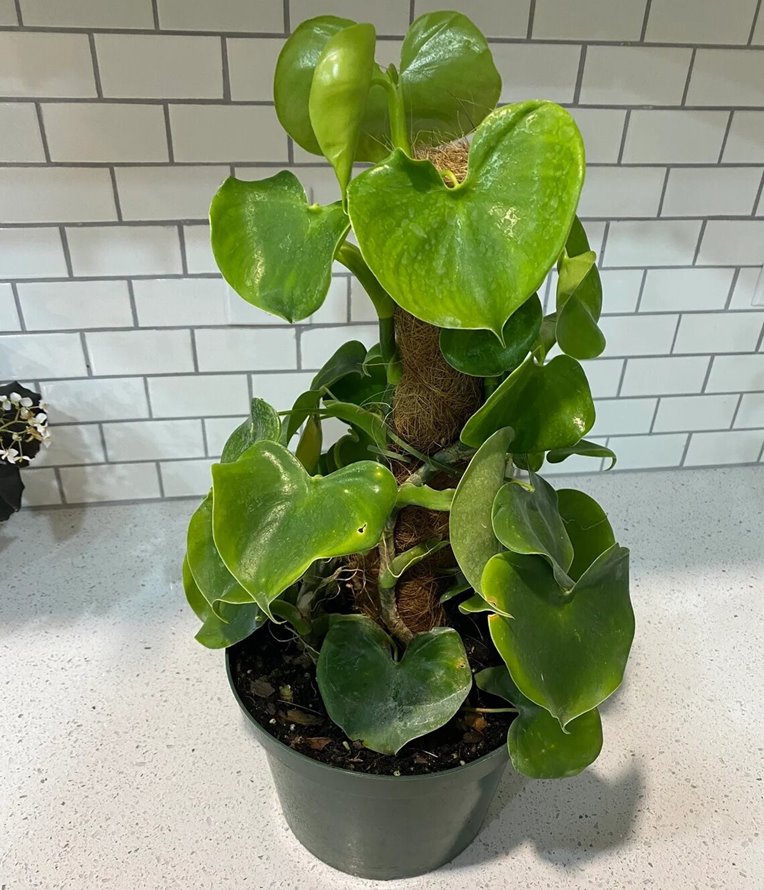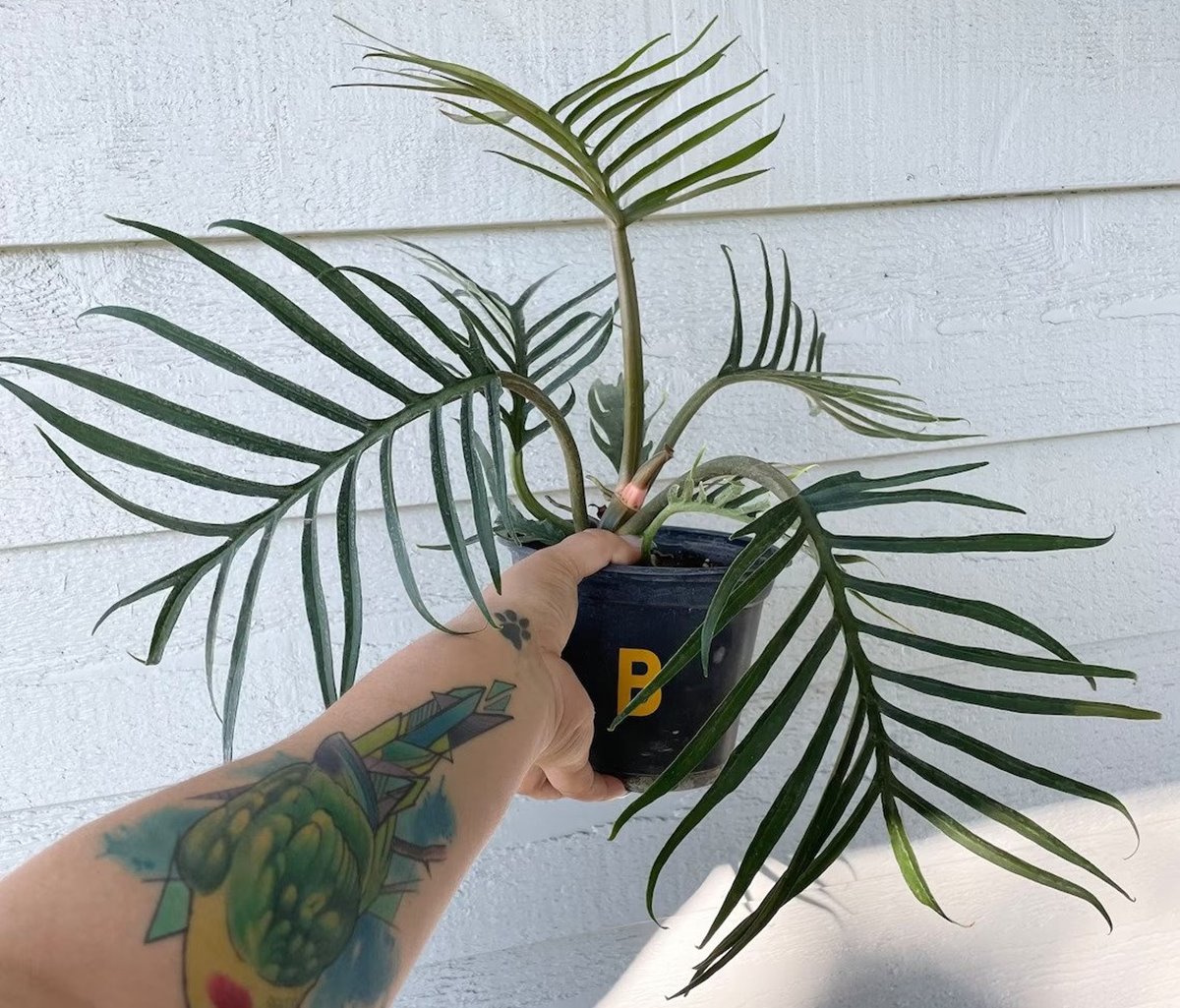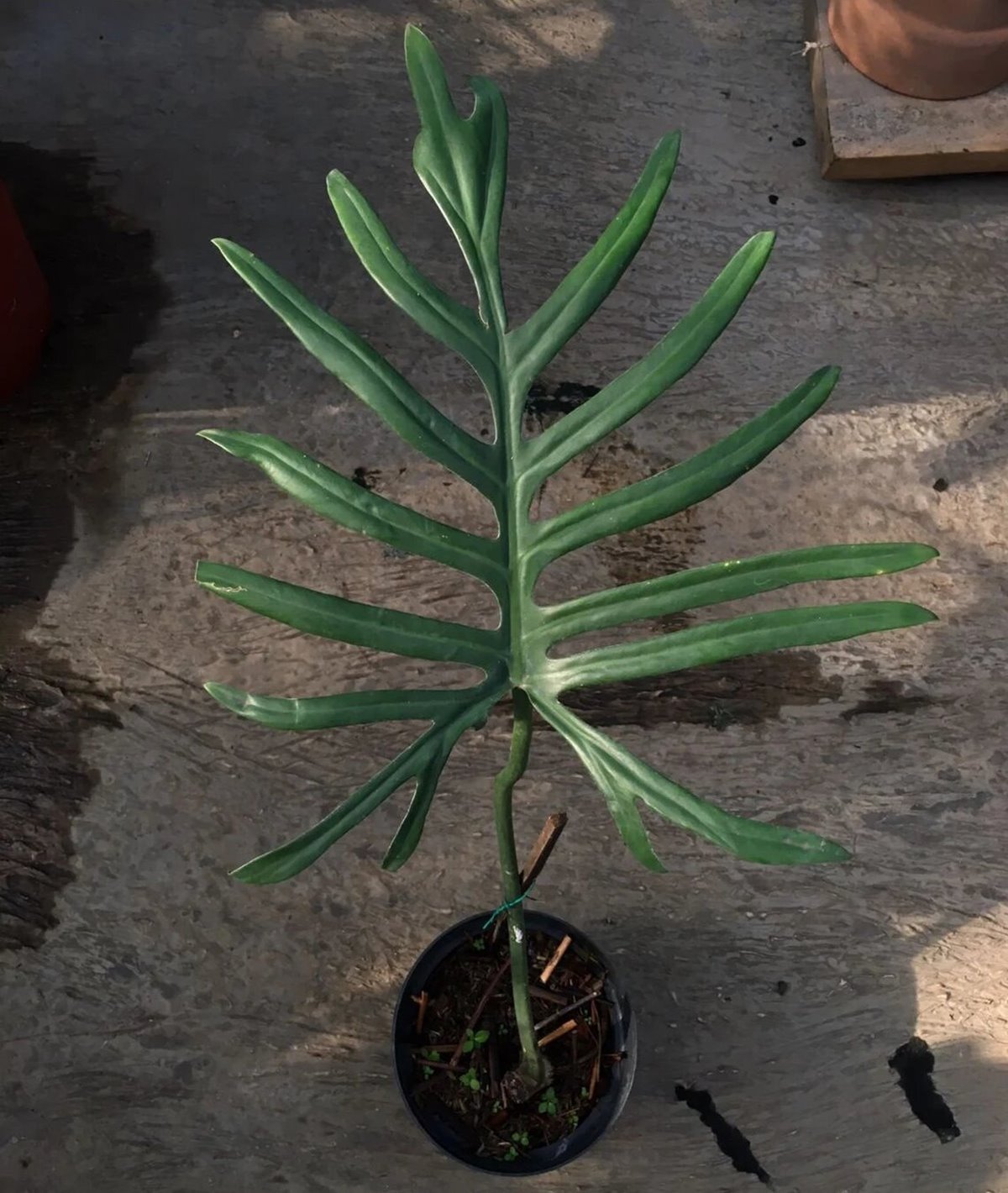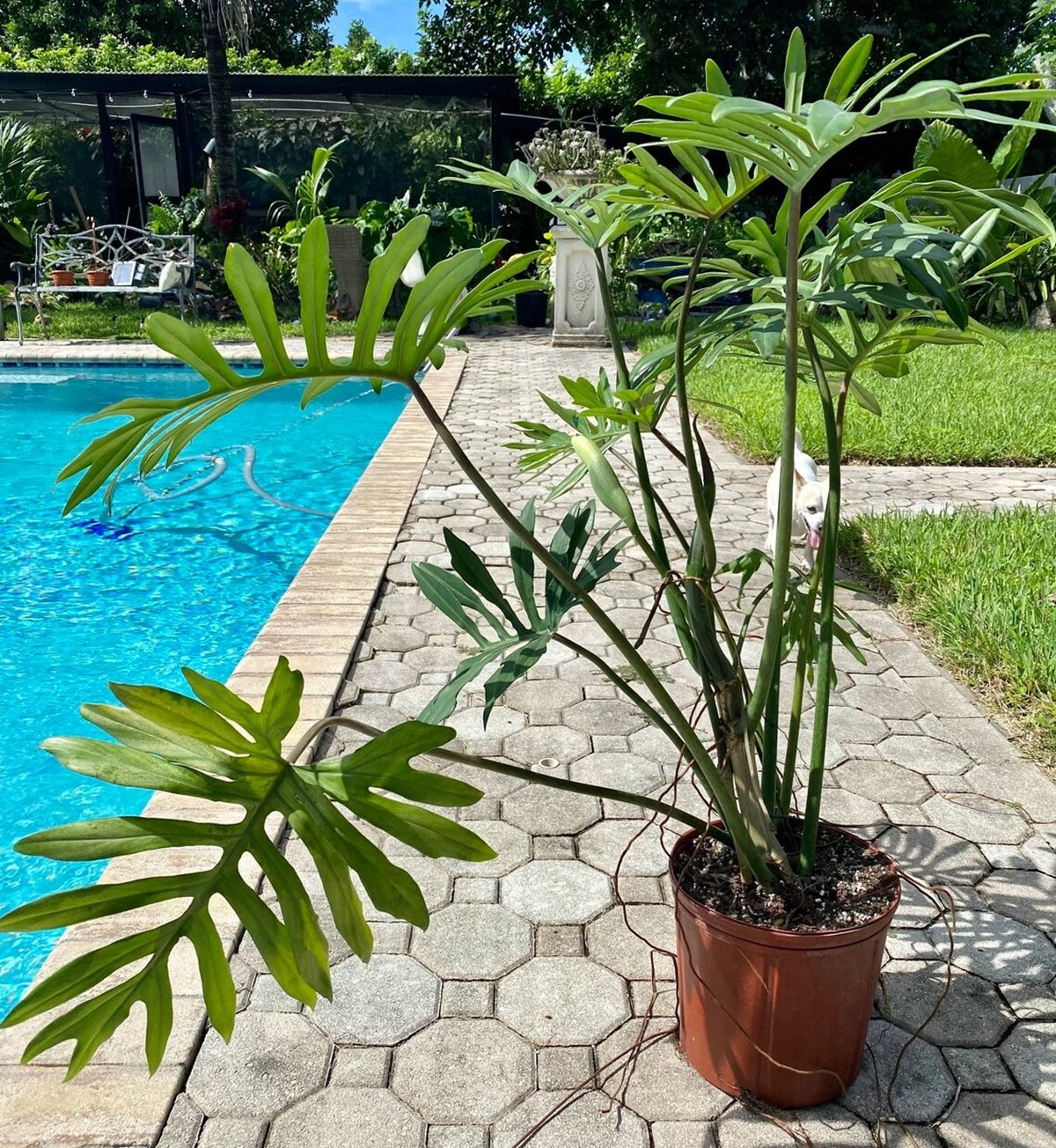Philodendron grazielae is a rare, evergreen climbing vine from Colombia, Peru, and Brazil. It has adorable, broadly heart-shaped thick, leathery, glossy green leaves with an inflexed long apex. A better way to describe the shape of the leaves is kidney-shaped with a heart-shaped base and a long tip.
Caring for this plant isn’t difficult so long as you have a warm, humid place with bright indirect light. Others needs like feeding, pruning, staking, etc., are straightforward. However, you should know it is sensitive to overwatering. Also, the potting mix must be loose, well-drained, and rich in organic matter.
Lastly, if you want to try this tropical plant, we have prices and the best places to find it, including Etsy and eBay.

Contents
- Overview
- Philodendron grazielae history and origin
- Philodendron grazielae identification and description
- 1. Growing habits
- 2. Growth rate and size
- 3. Leaves
- 4. Stems
- 5. Flowers
- Philodendron grazielae vs. microstictum
- Philodendron grazielae care and growth needs
- 1. USDA hardiness zone
- 2. Does it love humidity
- 3. Temperature
- 4. What are the Philodendron grazielae light needs
- 5. Philodendron grazielae soil mix
- 6. How should you water your grazielae
- 7. How do you feed it?
- 8. Should I prune or groom it?
- 9. How often to repot it?
- 10. Does it need a stake or moss pole?
- How do you propagate Philodendron grazielae?
- 1. Water propagation
- 2. Soil propagation
- Does grazielae have any issues or problems
- Where to buy Philodendron grazielae
- Frequently asked questions
Overview
- Scientific name: Philodendron grazielae
- Family: Araceae (aroids or arum family)
- Native habitat: Brazil, Peru, and Colombia
- Toxicity: Sap from all parts of this plant is toxic to humans, cats, and dogs. Why? Because it has insoluble calcium oxalates, a severe irritant.
- Maintenance: easy to care for or low maintenance
- Growth rate: Slow
- Good as: Indoor plants (container and hanging baskets) or shaded outdoor gardens, especially small ones.
Philodendron grazielae history and origin
Philodendron grazielae was published in 1963 by George Sydney Bunting (1927-2015).
G.S. Bunting was an American botanist and horticulturist renowned for his extensive work on Venezuelan flora. However, this plant is named after Grazielae Maciel Barroso (1912-2003), a top Brazilian Flora botanist.
Lastly, this aroid is native to Southern parts of Colombia (Maynas, Loreto) through to Peru and Northern Brazil. In Colombia, it occurs in Amazonia and Andes, while in Brazil, Amazonas, Acre, and Rondônia.
Philodendron grazielae identification and description
1. Growing habits
Philodendron grazielae is an evergreen, flowering climbing plant. This understory tropical rainforest climber occurs at 328-2756 feet (100-840m) above sea level. Here, it receives mainly dappled light from taller tree canopies.
Unlike most Philo plants, this plant doesn’t morph. So, mature Philodendron grazielae and juvenile or baby forms will look the same, except for slightly thicker stems and larger leaves in adult specimens. It is expected or normal.
2. Growth rate and size
Philodendron grazielae have a slow growth rate. However, they can get long if allowed to grow and given ideal conditions and a place to climb. For instance, they reach as high as 20 (6m) while climbing on trees in the wild (1).
However, at home, expect them to be 4 to 8 feet long. Also, provide them a place to climb, such as a totem, trellis, or moss pole.
3. Leaves
Philodendron grazielae has kidney-shaped with a heart-shaped base (or broadly heart-shaped), leathery, glossy green to dark green leaves that are paler below. These leaves are relatively smaller, i.e., they measure 3.7-4.3 inches wide and nearly equal in length but with a long (about 0.8 inches) reflexed apex.
Petioles are green, shiny, and shorter than lamina. Also, they have sheaths up to 0.4 from the base for those with flowers. But in some specimens, the sheaths may go up to half their length.
4. Stems
It has shiny green climbing stems with internodes about 1.6-2 inches. These stems have aerial roots at the nodes for climbing and water or nourishment.
5. Flowers
Mature Philodendron grazielae will produce inflorescences pairs. Each has a short light peduncle, spathe, and spadix.
The spathe isn’t the actual flower but a surrounding leaf-like bract. It is creamy white but pale green on the base. Also, it has a constriction on the middle that separates the upper blade and lower tube.
On the other hand, the spadix is what bears tiny flowers. The lowermost section is greenish and has female flowers, while the upper cream section bears male flowers, i.e., middle sterile and upper fertile male.
Philodendron grazielae vs. microstictum
Philodendron microstictum is different species from Costa Rica. Yes, it does resemble P. grazielae. However, it shouldn’t be so difficult to tell these two apart. Here is a table with the differences.
| Species | P. grazielae | P. microstictum |
| Leaf | It has smaller (3.7-4.3 inches), kidney-shaped with a heart-shaped base, leathery, glossy dark leaves with a longer (about 0.8 inches) inflex apex. | It has larger (up to 11.8 long by 8.5 inches wide), broadly oval subleathery, semi-glossy dark green leaves with a shorter (up to 0.2 inches) tightly rolled tip. |
| Petioles | It is slightly shorter than the leaf blade and doesn’t have a dark green ring at the apex. Also, this leaf stalk has a sheath halfway the length, except for leaves with flowers where it is only 0.4 inches the length. | The petiole is longer and sheathed to nearly half the length. However, it is about equal as long as the lamina. Also, it does have a dark green ring at the point it meats the leaf blade. |
| Inflorescences | They occur in pairs, are smaller, and the peduncle is much shorter. These inflorescences have a cream-white spathe. However, on the base, it Is pale green, just like the peduncle. | Only one larger per axil with a longer peduncle. The spathe is green outside and pale green inside the blade part, while it is green outside and violet-purple or red inside the tube. |
The above table shows that P. grazielae has a smaller, leathery and shinier leaf with a longer apex tip. In contrast, P. microstictum leaves are larger, less leathery, and shiny leaves with a shorter, tightly rolled apex.
Also, the leaf shapes vary, i.e., kidney-shaped with a heart-shaped base vs. broadly oval with a nearly heart-shaped base.
Philodendron grazielae care and growth needs
Philodendron grazielae prefers a warm (60-85°F), humid place (60% or more relative humidity) with bright indirect light. Its potting mix should be fertile, airy, and well-drained, and you should water it when the top soil starts drying, i.e., 1-2 inches, i.e., keep it moist, not soggy or bone dry.
Also, it needs pruning, feeding, repotting every few years, and a place to climb. A moss pole, trellis, or totem should do the job.
Here are more details on care needs and requirements for this lovely aroid:
1. USDA hardiness zone
USDA hardiness zone for this aroid is 10-11. It isn’t frost-hardy. Also, prolonged freezing will damage it. Only people in these zones can grow it outdoors all year.
2. Does it love humidity
P. grazielae prefers high humidity, i.e., about 60% or more. But it can still tolerate levels in most homes, thanks to the glossy, leathery, thick leaves.
If your home has very low humidity, you should try to raise it. Some telltale signs that your plant needs more humidity are wilting, leaf scorch, and brown tips or edges. Also, expect wilting, withering, leaves curling, etc.
To raise the humidity, mist your plant, have a pebble tray, or group your plants. Also, you can move them to a more humid room. Some of such spaces are your kitchen and bathroom.
However, buy a humidifier if your humidity is very low and you need better control. We have had an excellent experience with LEVOIT, especially LEVOIT Humidifiers Top Fill, 6 Liter, Cool Mist. It can cover a large room of up to 505 sq. ft and can run for up to 60 hours without a refill. Also, it comes with a Vesync APP and you can connect it to third-party voice assistants. But if you need a smaller one, AquaOasis™ Cool Mist Humidifier is perfect.
3. Temperature
As with any tropical plant, these aroids prefer warm places. A temperature range of 60-85°F (15.3-29°C) is perfect. Lower ones will slow growth, and at below 50°F, your plant will stop growing.
Also, don’t avoid cold drafts and sudden temperature changes. Similarly, don’t place your plant next to an AC or heating system vents. Even heat-emitting sources may harm your plant.
4. What are the Philodendron grazielae light needs
Philodendron grazielae require bright, indirect light for at least 8 to 10 hours daily. However, they can still grow just fine in lower light. But avoid very low will stunt growth and make your plant leggy. Also, new leaves will be smaller and paler.
So, if your room is poorly lit, consider buying grow lights. A trusted brand you can go for is GE Grow Light LED Flood Light Bulb. This brand of grow light is made by Savant Systems Inc. and will give you at least 25000 hours. Also, it is very affordable.
On the other hand, too much or direct hot sun is good either. It will scorch leaves and make them curl. Signs include brown tips and edges or leaves looking faded, paler, or washed-out.
Indoors, place this plant on a spot it gets bright but indirect light. No direct sun saves early morning sun for those with the east-facing window. Also, rotate your plant for balanced growth.
Lastly, if you grow your P. grazielae outdoor, select a place with dappled light. If not, you need a shade cloth.
5. Philodendron grazielae soil mix
The best soil mix for your P. grazielae should be well-drained, aerated, and rich in organic matter. Also, its pH should be slightly acid to neutral.
Buy an aroid mix (Etsy.com has best mixes) or make one by mixing 50% regular potting soil, 20% peat moss (or coco coir), 10% bark chips, 10% perlite, and 10% compost or worm castings.
Don’t worry about the exact ratios. All you need to do is ensure that your potting mix drains but retains moisture. Also, it must be fertile, a reason for compost or worm castings.
Lastly, avoid heavy or compact soils. They will only serve to increase the risk of root rot.
6. How should you water your grazielae
How you water this plant is one area you must be very careful of, especially if you overdo it. We have found this plant more vulnerable to root rot than other Philo plants when overwatered.
We recommend you water your grazielae when the top 1-2 inches of the potting mix feel dry. Test the soil. If the potting mix feels dry up to the first knuckle, water it.
Alternatively, you can test it with a soil moisture meter and water when the reading is in a dry area. For most brands, including XLUX, it will be less than three. Don't follow a watering schedule.
Lastly, when watering, evenly pour water until excess flows from the drainage holes. Then discard any that collects on the saucer.
7. How do you feed it?
Your plant stands to benefit from additional nutrients from plant foods. So, feed your plant monthly during growth months using an all-purpose, balanced (NPK 10-10-10 or 20-20-20, etc.) liquid fertilizer for indoor plants. Dilute it to half recommended strength and reduce the amount of your plant in lower light.
On specific brands, you are free to select from the many available. We use Miracle-Gro Indoor Plant Food since it is balanced and easy to apply. You can use it directly or mix it with water.
For those that prefer slow-release formulas, they are also perfect. Just settle for one for indoor plants. A good pick is Osmocote Smart-Release Plant Food Plus Outdoor & Indoor. Apply at a rate of 1 teaspoon per 64 square inches.
Lastly, to avoid salt buildup in the soil from plant foods, flush the potting once every six months.
8. Should I prune or groom it?
It doesn’t need much pruning except for routine removal of dead, damaged, or diseased parts or leaves. Use sterilized gardening shears. Also, clean dirty or dusty leaves.
However, to control the size of your plant, you can cut back the stems. Trim it in early spring or summer and cut no more than 25% at one ago.
9. How often to repot it?
This aroid requires repotting every 2-3 years or when rootbound. Signs your plant has overgrown the current pot are roots growing from drainage holes and spiraling inside the planter. Also, your plant will be leggy and grow slowly. More signs will resemble those of a thirsty plant.
When repotting, use a pot 3-4 wider in diameter. Any time is ok. But we recommend spring or early summer. Your plant needs time to root before the colder months.
10. Does it need a stake or moss pole?
We recommend providing and training your P. grazielae on a moss pole, trellis, or totem for best growth. We know some people opt for hanging baskets. Some may let it drape onto a desk, cabinet, etc. However, we don’t think they are the best choice.
How do you propagate Philodendron grazielae?
The best way to propagate Philodendron grazielae is by stem cutting in water or soil. However, you can still go for air layering. Seeds are hard to find.
Air layering involves wrapping selected nodes of stems with moist sphagnum moss while still attached to the mother plant. Keep the moss airy and moist until the roots are long enough. Then you can cut and plant it.
On the other hand, stem cutting requires a stem with at least a node. You cannot use one without a node, a leaf with petiole, or aerial roots.
1. Water propagation
This method is the most effortless. Also, you will see your plant root. However, it will not get nutrients in the soil and may suffer shock when transplanted.
What you need
- Jar
- Gardening scissors
- Rooting hormone – optional but will speed rooting and prevent any rotting. We use HydroDynamics Clonex Rooting Gel, a water-based formula. It has hormones and some vital nutrients to support growth.
- 70-90% rubbing alcohol – it will be handy in sterilizing your gardening scissors
Steps
- Select a healthy stem with at least one or two nodes and cut it below the lower node with your sterilized gardening shears. If it has more than two leaves, snip off the lower ones.
- Apply your rooting hormone on the cut end. As you do so, ensure you cover the nodes you will dip inside the water.
- Fill your jar with chlorine-free water and dip your stem cutting. Make sure the nodes are underwater. However, don’t immerse leaves.
- Place your cutting in a warm place with bright, indirect light.
- Change the water after 4-5 days and refill it when the level drops.
Rooting will occur after 5 to 7 weeks, depending on your condition. Also, you will see new growth. When these roots are long enough, 2-3 inches or more, transplant the cutting.
2. Soil propagation
It allows faster rooting, and plants benefit from nutrients in the soil. Also, cuttings suffer less transplant shock. Nonetheless, some people say it is messy.
After step 2 above, you will plant the cutting in soil and thoroughly water it. Afterward, you will place it in a warm, humid area with bright, indirect light.
Here is a video to guide you more on propagation:
Does grazielae have any issues or problems
This species isn’t vulnerable to any unique pest or disease. So, it may have mealybugs, thrips, scale insects, aphids, or even spider mites. Luckily, the chances are low, especially indoors.
Similarly, it may have fungal or bacterial leaf spots or blights. Again, these diseases are uncommon. Just ensure proper sanitation and isolate new plants.
An issue perhaps we have seen more often than other Philodendron species is root rot due to overwatering. Please stick to the watering guide we gave you. Also, avoid oversized pots and poorly draining potting mix.
Root rot, improper care, and wrong growth conditions may cause leaf discoloration or curling. Also, your plant may wilt or droop. Here is a summary
| Issues | Possible causes |
| Philodendron grazielae leaves turning yellow | It is a likely sign of overwatering. But it can be too much or little light, cold drafts, heat stress, underwatering, lack of nutrients, etc. Also, don’t rule out plant shock. But a few lower leaves turning yellow may be normal aging. |
| Brown tips and edges | It may indicate underwatering, low humidity, heat stress, fertilizer burns, too much light, etc. However, repotting or transplant shock may also be to blame. |
| Brown or yellow spots | Pests or disease |
| Drooping or leaves curling | Your plant is thirsty, humidity is low, or temperatures are high. Also, too much light and root rot may be to blame. |
Where to buy Philodendron grazielae
If you are looking for Philodendron grazielae on sale, start with Etsy.com and eBay. These two are our favorite places. Why? Because they have vendors from all over the world, including the UK, Canada, Australia, NZ, etc., not just the US. Also, Facebook and Instagram are good places.
Other places to find Philodendron grazielae in the US and their respective prices include the following:
- Glass Box Tropicals (Lansing, Michigan) - $44.99
- Exotic Forest (Palm Beach, FL) - $60.00
- Peace Love and Happiness Club (Seattle, WA) -$ 54.00
- Glasshouse Works (Stewart, OH) - $35.00
- NSE Tropicals (Plantation, FL) - $49.00
- Bold Botanicals TX (Austin, TX) - sold out
Some of these online vendors ship nationally, while others are within some regions. Kindly confirm if they send to your location.
Lastly, try googling for “Philodendron grazielae for sale” for locations. You are likely to get more places near you.
Frequently asked questions
Yes. Philodendron grazielae is a rare plant that very few vendors have. Largescale horticulturalists like Costa Farms and big box stores don’t sell it. Also, most of the tropical plant vendors don’t have it yet.
Philodendron grazielae price ranges from $30 to $80. These costs depend on where you buy your plant and its size, i.e., is it a cutting or an established plant? Some vendors sell it for as high as $300.
If you want your P. grazielae bushy, you grow several cuttings in the same pot and provide ideal growing conditions. Also, regular pruning may encourage branching.
No. We have not seen anyone selling a variegated Philodendron grazielae. However, such a plant can exist since variegation occurs from rare cell mutation.





Leave a Reply